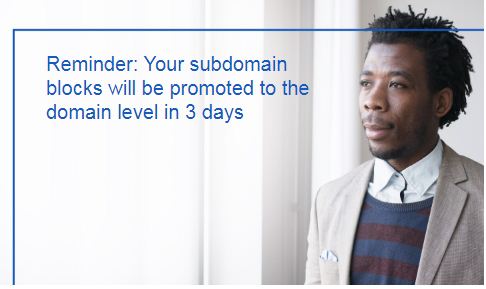Your subdomain blocks will be promoted to the domain level in 3 days | what is subdomain
Your subdomain blocks will be promoted to the domain level
in 3 days. This message was received by the Google AdSense to all the users. This
massage is a part of last notification that was sent by the Google AdSense about
the Site management in AdSense is changing.
A subdomain is a part of a larger domain name in the Domain
Name System (DNS) hierarchy. It is the prefix name that appears before the main
domain name, separated by a dot (e.g. "blog" in
"blog.example.com").
A subdomain can be used to organize and categorize different
sections or functions of a website, or to create distinct web addresses for
different purposes. For example, a company might use subdomains like
"shop.example.com" for their online store,
"support.example.com" for customer support, and "blog.example.com"
for their blog.
Subdomains are often used to create unique addresses for
specific areas of a website or for different services or applications that are
hosted on the same domain name. They can also be used for testing and
development purposes, or to create separate sub-sites within a larger website.
How subdomains work?
Subdomains work by creating a separate DNS record in the
Domain Name System (DNS) hierarchy for each subdomain. Each subdomain has a
unique name that precedes the main domain name, and can be associated with a
different IP address or server.
When a user enters a subdomain name in their web browser,
the browser sends a request to the DNS system to translate the subdomain name
into an IP address. The DNS system looks up the corresponding DNS record for
the subdomain and returns the IP address to the user's browser. The browser
then connects to the IP address to retrieve the content associated with that
subdomain.
For example, if a user types "blog.example.com" in
their web browser, the DNS system will look up the DNS record for the
"blog" subdomain and return the IP address associated with it. The
browser will then connect to that IP address and retrieve the content
associated with the "blog" subdomain.
Subdomains can be used to organize a website into different
sections or categories, or to create separate web addresses for different
purposes. They can also be used to host different services or applications on
the same domain name.
Site management in AdSense is changing
Yes, that's correct. Google AdSense is changing the way site
management works for publishers. The new site management system is designed to
make it easier for publishers to manage and monetize their websites with
AdSense.
Under the new system, publishers will be able to manage
their sites at the domain level, rather than managing individual pages or ad
units. This means that once a domain is added to the AdSense account,
publishers can easily create and manage ad units for any page on that domain
without having to manually add each page or ad unit individually.
In addition, the new site management system will provide
more detailed information about each site in the account, including traffic and
revenue data for each domain. This will allow publishers to better understand
how their sites are performing and make more informed decisions about their
monetization strategy.
Overall, the new site management system is designed to make
it easier and more efficient for publishers to manage and monetize their
websites with AdSense. Publishers who use AdSense should stay updated on the
latest changes and best practices to ensure they are maximizing their earnings
potential.
Your subdomain blocks will be promoted to the domain level in 3 days
As per my knowledge, I don't have access to specific
information about individual websites or their subdomains. However, if you have
received a reminder that your subdomain blocks will be promoted to the domain
level in 3 days, it is likely related to changes in the site management system
for Google AdSense.
Under the new site management system, publishers will be
able to manage their sites at the domain level rather than managing individual
pages or ad units. This means that any subdomains associated with a particular
domain will be promoted to the domain level for AdSense management purposes.
If you have received this reminder, it is important to
review your AdSense account settings and ensure that your domains and
subdomains are properly configured and in compliance with AdSense policies.
This will help ensure that your AdSense account continues to function properly
and that you are maximizing your earnings potential.
What AdSense users can do?
As an AdSense user, there are several things you can do to
manage and optimize your account:
Review
and follow AdSense policies: It's important to review and follow
AdSense policies to ensure that your account is in compliance and to avoid
violations or account suspension.
Optimize
your ad placement: Experiment with different ad placements and sizes
to find the best combination for your website. Place ads where they are most
likely to be seen by visitors without disrupting the user experience.
Monitor
performance and make adjustments: Use AdSense reports to monitor the
performance of your ads and make adjustments as needed. This may include
adjusting ad formats, placements, or targeting options.
Consider
using other AdSense products: AdSense offers a variety of other
products, such as matched content and link units, that can help you monetize
your website and improve the user experience.
Keep your
website up-to-date: Regularly update your website with fresh content
and ensure that it is mobile-friendly and optimized for search engines. This
can help attract more visitors and improve ad performance.
By following
these best practices and regularly monitoring and optimizing your
AdSense account, you can maximize your earnings potential and create a positive
experience for both your website visitors and advertisers.
What kind of action should be taken by AdSense Users?
If you have received a message from Google stating that site
management in AdSense is changing, there are several actions you should take:
Review
the changes: Take the time to review the changes to the site
management system in AdSense and understand how they will impact your account.
Check
your domains: Ensure that all of the domains associated with your
AdSense account are properly verified and configured. This will help ensure
that you can continue to manage your sites effectively under the new site
management system.
Update
your site management settings: If necessary, update your site
management settings to ensure that your domains are organized and managed in a
way that works best for you. This may include creating site groups or managing
domains at the domain level.
Monitor
your account performance: Keep an eye on your AdSense account
performance to ensure that your ads are being displayed and generating revenue
as expected. Adjust your settings or ad placements as needed to optimize your
account performance.
Stay
informed: Stay up-to-date on changes to the AdSense program and
other best practices to ensure that you are maximizing your earnings potential
and complying with AdSense policies.
By taking these
actions, you can ensure that your AdSense account continues to function
effectively and that you are maximizing your earnings potential under the new
site management system.
FAQ'S
Here are some frequently asked questions (FAQs) about the
changes to site management in AdSense:
Q: What is changing in AdSense site management?
AdSense is changing the way site management works for
publishers. Under the new system, publishers will be able to manage their sites
at the domain level, rather than managing individual pages or ad units.
Q: When are the changes taking effect?
The changes to site management in AdSense have already taken
effect.
Q: How will the changes impact my AdSense account?
The new site management system is designed to make it easier
and more efficient for publishers to manage and monetize their websites with
AdSense. Once a domain is added to the AdSense account, publishers can easily
create and manage ad units for any page on that domain without having to
manually add each page or ad unit individually.
Q: Do I need to take any action to adjust to the changes?
If you have already added your domains to your AdSense
account, you do not need to take any immediate action. However, it is
recommended that you review your site management settings and ensure that your
domains are properly configured and organized for optimal management and
monetization.
Q: Will the changes impact my AdSense earnings?
The changes to site management in AdSense are not expected
to impact earnings directly. However, optimizing your site management settings
and taking advantage of the new features may help you increase your earnings
potential.
Q: Where can I learn more about the changes to site management in AdSense?
You can find more information about the changes to site
management in AdSense on the AdSense Help Center or by contacting AdSense
support.
Latest Articles
- AllstateComprehensive Insurance Coverage: What It Covers
- Metromile Insurance Claims and phone number
- Kin Insurance Florida: The Pros and Cons
- Everything You Need to Know About Debt Consolidation loan
- American Mortgage Consultants News What It Is and How It Works
- homeloan calculator | what is homeloan
- What isF1 formula 1 news for f1









What should blogspot bloggers do?
ReplyDeleteOne of my blogspot blog is: popular-opinion.blogspot.com
Please advise. Thanks
Sir, Google just going to remove subdomain features not domain.so be easy.
DeleteThank you for your reply. In that case blogspot bloggers like me need not do anything?
DeleteOf course :)
Delete